Characteristics of Oceania

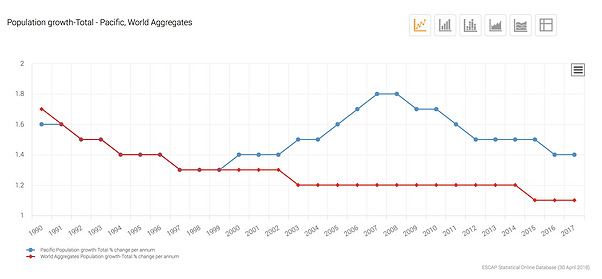
Oceania is the smallest continental grouping in land area and the second smallest in population after Antarctica. It covers an area of 9,008,458 km² and has a population of about 40 million.
Demographics
Oceania has a population of 40,117,432 (2016). The largest and most populous country in Oceania is Australia, with Sydney being the largest city of the whole region.
According to a UN regional fact sheet on international migration, migration accounts for one quarter of population growth in Oceania, with the number of migrants in the region increasing from 4.8 million to 5 million over the period 1990–2005.
Pacific population (thousands of people)
Population growth (% change per annum) in the Pacific (blue) and in the world (red)

Pacific foreign population (% of population)

Pacific population by gender (thousands of people)
Economy
In terms of economy, Oceania is a very heterogeneous region. On one hand, there are countries with highly developed and globally competitive financial markets, such as Australia and New Zealand, which are engaged in a bilateral free trade agreement called Closer Economic Relations. These two countries are considered to be the only developed nations of Oceania; nonetheless, Australia’s economy is by far the largest and the most dominant in the region, as well as one of the largest in the world. On the other hand, there are countries, such as Kiribati and Tuvalu, which are small in size, have limited natural resources and are at a large distance from major markets. This makes their narrowly-based economies much less developed and vulnerable to climate change and disasters. However, this is not the case of all Pacific islands nations; Fiji and Palau, for instance, have “medium-sized” economies. Despite remaining a developing country, Fiji’s economy is one of the strongest among the Pacific islands, as its territory is well provided with mineral and other natural resources.
As for economic sectors, the vast majority of Pacific islands population works in the service industry, namely tourism and financial services. Agriculture and fishing also contribute significantly to Oceanian economies, especially to those of the less developed Pacific islands nations. In Vanuatu and in Fiji, for instance, more than 80% and 70% of the population, respectively, is employed in the agricultural sector. The main products are coconut and coconut by-products, as well as palm oil, cocoa and sugar. Oceania's largest export markets include Japan, China, the United States, South Korea and the European Union, while the smallest Pacific nations rely on trade with Australia, New Zealand and the United States for exporting and importing goods.
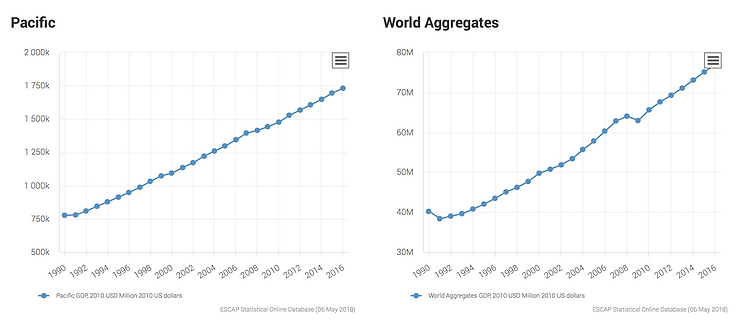
Left: Pacific GDP (million 2010 US dollars)
Right: World GDP (million 2010 US dollars)
2005 USD GDP growth rate (total % change per annum) in the Pacific (blue) and in the world (red)

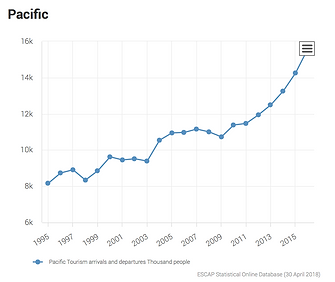
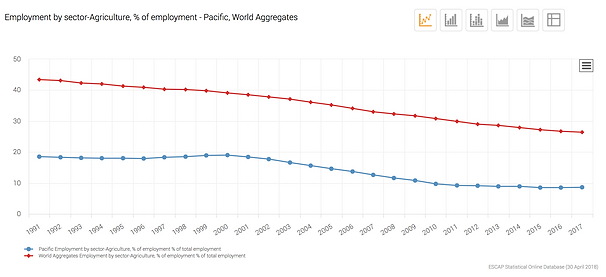
Culture
Culturally, Oceania is divided into three major areas: Micronesia, Melanesia and Polynesia. Some also consider Australia a fourth one.
Religion
The predominant religion in Oceania is Christianity (73%), with more than 90% of Melanesia, Micronesia and Polynesia inhabitants describing themselves as Christians. Christianity coexists with other religions, such as Islam, Buddhism and Hinduism in Australia and New Zealand, and traditional religions, mainly animist, which prevail among traditional tribes. These are based on the belief in spirits representing natural forces.
Languages
When it comes to the languages spoken in Oceania, one could distinguish colonial languages from native languages. As for colonial languages, English is the de facto predominant language in Australia and New Zealand; while French is spoken in New Caledonia and French Polynesia, Japanese in the Bonin Islands and Spanish on Easter Island. Regarding indigenous languages, Oceania has many of them, and in great variety. However, they are not evenly distributed: Melanesia and Australia alone, for instance, are home to 5000 languages, while Polynesia lacks such diversity. Native languages of Oceania fall into three major geographic groups:
-
The Austronesian language family, the fourth largest family language in the world, with such languages as Malay (Indonesian), and Polynesian languages such as Maori and Hawaiian.
-
The Aboriginal Australian languages, spoken in mainland Australian and a few neighbouring islands.
-
The Papuan languages of New Guinea and neighbouring islands, a strictly geographical grouping of languages that includes the large Trans–New Guinea family.
Art
Oceanic art comprises the creative works made by the native people of the Pacific Islands and Australia (including the remote areas of Hawaii and Easter Island), and varies significantly through cultures and subregions. On a deeper level, it comprehends the work of two groups of people who, despite settling the region in two different periods, came into contact over time. On one hand, we find the Lapita, an ancestral culture shared by the regions of Polynesia and Micronesia; on the other, culture descending from the first wave of settlers is shared by the regions of Australasia and Melanesia. Nonetheless, all regions were later influenced by western culture during colonization.
Despite the differences, native creations from across the region share some common traits. The main subject of creations is typically fertility or the supernatural. Furthermore, some creations can be found recurrently across communities, such as masks (which are used in religious or social rituals), sculptures, painting, tattooing and wood or stone carving.
Pacific tourism arrivals (thousands of people)
Employment in agriculture (% of employment) in the Pacific (blue) and in the world (red)
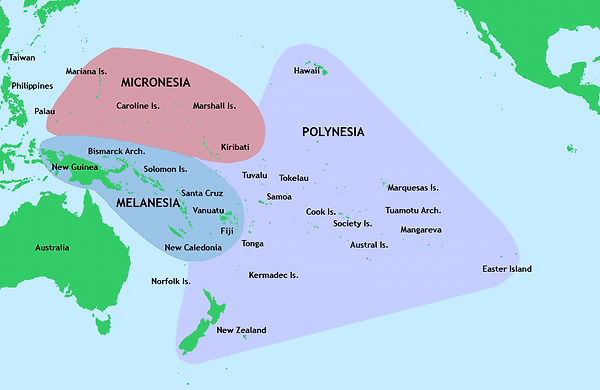


The three main cultural areas in the Pacific. Source: Wikipedia
Moai statues created by Rapa Nui people, Polynesian inhabitants of Easter Island. Source: NY Times (left); National Geographic (right).
Geography and environment
Geography
Geographically, Oceania is divided into four regions: Australasia, Micronesia, Melanesia and Polynesia. Although the exact scope of Oceania is open to multiple interpretations, Oceania is generally said to extend to New Guinea in the west, the Bonin Islands in the northwest, the Hawaiian Islands in the northeast, Easter Island in the east, and Macquarie Island in the south. Most Oceania islands, but not all, are located in South Pacific.
Oceanian islands are of four basic types, depending on their geological formation:
-
Continental islands: bodies of land that were once attached to continents before sea level changes and tectonic activity isolated them, and that now lie on the continental shelf of a continent . E.g: Kangaroo Islands off Australia
-
High islands: islands of volcanic origin. High islands are formed when volcanic eruptions begin under water. Hot magma is then cooled and hardened by the ocean, resulting, over time in islands with a steep central peak—hence the name “high island.” The term is used to distinguish volcanic islands from low islands, which are of coral origin (whether they are formed as a result of sedimentation upon a coral reef or of the uplifting of such islands). E.g: Hawaiian islands.
-
Coral reefs: a type of island formed from coral detritus and associated organic material. The coral reefs of the South Pacific are low-lying structures that have built up on basaltic lava flows under the ocean's surface. E.g: Great Barrier Reef.
-
Uplifted coral platforms: also formed of coral, but usually slightly larger than the low coral islands.
Flora and fauna
The evolution of flora and fauna across Oceania is unique. Many plants and animals reached the islands from southern Asia during the last glacial period, when low sea levels allowed them to travel. After sea levels rose, species became isolated from the rest of the world and adapted to the specific environment of each island or archipelago, producing multiple species that descend from a common ancestor. As a result of this process, Oceania has an incredibly high number of endemic species, that is, species that can only be found in this region and that therefore possess and extraordinary value.
One can more easily think of this migration and adaptation process carried out by animal species rather than plants. However, plants also traveled between islands by means of wind or ocean currents, as the seeds and spores of some of them can remain in the air or in the water for long periods of time, travelling long distances. Seeds can also be carried by animals, namely birds, which were the main responsible for the spreading of the seeds of fruits between islands. Birds, especially seabirds, are very common in Oceania as they are mobile enough to move from island to island.
As for the native species of flora and fauna, some native vegetal species include coconut palms, the jacaranda, eucalyptus, pohutukawa and the breadfruit. Native land animals are rarer, however Australia is famously known for being home to monotremes, such as the platypus.
Lastly, one could not review Oceania’s flora and fauna without making any reference to the marine species. The region of Oceania is composed of three marine realms, which are large ocean extensions in which animal and vegetal species are similar due to shared environmental conditions and evolutionary factors. These three marine realms are Temperate Australasia (very rich in seabird species), Central Indo-Pacific (an area with a great diversity of tropical coral, and that includes the world’s two largest coral formations, Australia’s Great Barrier Reef and the New Caledonia Barrier Reef) and Eastern Indo-Pacific (known as well for its coral formations). Nonetheless, IUCN Red List Status of Marine Species indicates that 196 species, which account for 17% of all marine species in Oceania, are in some threatened category (Critically Endangered, Endangered or Vulnerable). Of all these 196 threatened species, 140 are reef-building corals. Another 16% (187 species) of the overall Oceanian species are qualified as Nearly Threatened. This means that one-third (383 species) of all species assessed in Oceania are listed in threatened or Near Threatened categories. Threats are mainly caused by the modification or destruction of coastal habitats, overfishing, pollution and other ecological or environmental changes associated with climate change.
To see the numbers and proportions of species in the IUCN Red List of Threatened Species in Oceania, click here.


Oceania regions (left) and extension of Oceania (right). Source: Wikipedia
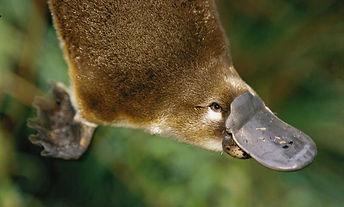

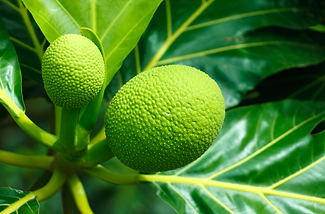
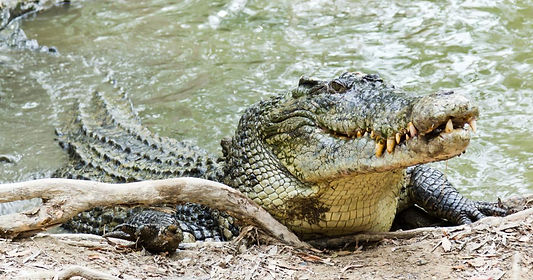

Left: Breadfruit (Artocarpus altilis). Source: Fresh Fruit Portal
Right: Pohutukawa or New Zealand Christmas tree. (Metrosideros excelsa). Source: Wikipedia
Top-left: Platypus (Ornithorhynchus anatinus). Source: World Atlas
Bottom-left: Kiwi bird. Source: EcoBirdy
Right: Saltwater crocodile (Crocodylus porosus). Source: World Atlas

Great Barrier Reef in Australia. Source: National Geographic